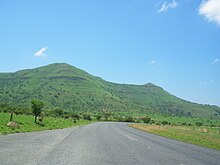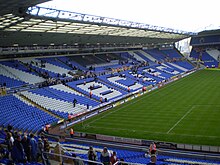Spion Kop (stadiums)


Spion Kop (or the Kop for short) is a colloquial name or term for a number of single-tier terraces and stands at sports stadiums, particularly in the United Kingdom. The steep nature resembles the Spion Kop, a hill near Ladysmith, South Africa, which was the scene of the Battle of Spion Kop in January 1900 during the Second Boer War.
History
[edit]
The first recorded reference to a sports terrace as "Kop" related to Woolwich Arsenal's Manor Ground in 1904, four years after the Second Boer War.[1][2] A local newsman likened the silhouette of fans standing on a newly raised bank of earth to soldiers standing atop the hill at the Battle of Spion Kop. Two years later in 1906, Liverpool Echo sports editor Ernest Edwards noted of a new open-air embankment at Anfield:
This huge wall of earth has been termed "Spion Kop", and no doubt this apt name will always be used in future in referring to this spot.
The use of the name for the stand was given recognition at Anfield in 1928 when it was extended to a 27,000 capacity and a cantilever roof was added which amplified the roar of the crowd to create an intense atmosphere.[2] Traditionally, Liverpool's most vocal supporters congregate in this stand and are referred to as kopites.[3] Such is the reputation of the stand that it was claimed that the crowd in the Kop could suck the ball into the goal and it has become one of the most famous football stands in the world.[4]
Liverpool's Spion Kop (capacity 27,000, although crowds of 30,000+ have been recorded) was redesigned in 1994 (completed) to comply with requirements of the Taylor Report, which made all-seater stadiums obligatory in the highest two divisions of English football. A new Spion Kop was built in its place with 12,390 seats, making it the largest single-tier stand in the country at the time. This new Kop still stands and currently houses the club's museum.
Following the opening of the new Tottenham Hotspur Stadium, Anfield's Kop ceased to be the largest single-tier stand in the country. The South Stand of the new stadium has 17,500 seats and has an incline of 34 degrees, making it one of the steepest stands in the country.[5]
Villa Park's old Holte End was historically the largest of all Kop ends, closely followed by the old South Bank at Molineux, both once regularly holding crowds in excess of 30,000.[2]
Many other English football clubs and some rugby league clubs (such as Wigan's former home Central Park) applied the same name to stands in later years.[citation needed]
Composition
[edit]There is much debate about what type of stand constitutes a Kop.[citation needed] The size and location of the stand in the stadium varies; most are located behind the goal and are occupied by its club's most vocal supporters. It is usually a single-tiered stand and was traditionally terraced. In England, safety regulations brought into effect after the 1989 Hillsborough disaster required many to be made all-seated. A Kop is not necessarily the largest stand in the stadium and does not have to have a particularly large capacity; for example, Chesterfield's former stadium, Saltergate, had a Kop with a capacity of only a few thousand.
Kops
[edit]




References
[edit]- ^ a b "Showdown in Durban". The Globe And Mail. 25 June 2010. Archived from the original on 4 March 2016. Retrieved 5 October 2023.
- ^ a b c Irwin, Colin (2006). Sing When You're Winning. Andre Deutsch. p. 164. ISBN 978-0233001845.
- ^ "Football First 11: Stunning stadiums". CNN. Archived from the original on 10 February 2009. Retrieved 29 October 2008.
- ^ Burt, Jason (16 January 2011). "Liverpool 2 Everton 2: match report". The Daily Telegraph. London. Retrieved 12 July 2011.
- ^ White, Jim (22 March 2019). "Tottenham Hotspur's new home sets benchmark for modern stadia". The Telegraph. ISSN 0307-1235. Retrieved 24 February 2020.
- ^ Pearce, James (23 August 2006). "How Kop tuned in to glory days". Liverpool Echo. Archived from the original on 10 February 2009. Retrieved 7 April 2010.
- ^ Hadfield, Dave (3 September 1999). "Rugby League: Curtain falls on house of fame". The Independent. London. Archived from the original on 24 May 2022. Retrieved 6 April 2010.
- ^ "derbycountyfootballhistory.co.uk". Archived from the original on 4 August 2013.
- ^ "Blackpool". Football Ground Guide. Retrieved 6 April 2010.
- ^ "Sheffield United". Football Ground Guide. Retrieved 6 April 2010.
- ^ "County Ground, Northampton". Football Ground Guide. Archived from the original on 25 November 2009. Retrieved 9 April 2010.
- ^ "Preston North End". Football Ground Guide. Retrieved 9 April 2010.
- ^ "ARTISTS IMPRESSIONS – ELLAND ROAD FOR WORLD CUP". Leeds United AFC. 1 December 2009. Retrieved 30 June 2010.
- ^ "Filbert Street Leicester City". Football Ground Guide. Archived from the original on 31 December 2009. Retrieved 13 April 2010.
- ^ "Fratton Park Portsmouth". Football Addict. 21 September 2018. Retrieved 30 July 2019.
- ^ "Highfield Road, Coventry City". Football Ground Guide. Archived from the original on 28 March 2008. Retrieved 13 April 2010.
- ^ "The ASD Lighting Kop". Sheffield Wednesday F.C. Archived from the original on 3 January 2011. Retrieved 7 April 2010.
- ^ "Londons Stadium History". West Ham United. Retrieved 8 April 2024.
- ^ "Notts County | Club | Meadow Lane | Meadow Lane — The Home Of Notts County FC". Nottscountyfc.premiumtv.co.uk. Retrieved 7 April 2010.
- ^ "Oakwell | Barnsley FC | Football Ground Guide". January 2010.
- ^ "Tranmere Rovers". Football Supporters Federation. Archived from the original on 30 December 2010. Retrieved 9 April 2010.
- ^ "Chesterfield". Football Ground Guide. Retrieved 20 April 2010.
- ^ "St Andrew's Stadium Plan" (PDF). Birmingham City F.C. Archived from the original (PDF) on 31 March 2010. Retrieved 7 April 2010.
- ^ "La tribune Ouest Kop". www.rcstrasbourgalsace.fr (in French). 16 June 2016. Retrieved 24 May 2017.
- ^ "Bradford City". Football Ground Guide. Retrieved 7 April 2010.
- ^ "The Walkers Stadium". Leicester City F.C. 22 September 2009. Archived from the original on 25 January 2010. Retrieved 7 April 2010.
- ^ "Alex Russell Stand reverts back to "Kop Stand" name". Linfield F.C. 4 December 2008. Archived from the original on 30 September 2011. Retrieved 30 June 2010.
- ^ "Kop Of Boulogne, une histoire devenue légende". www.lagrinta.fr. 20 October 2013. Retrieved 6 October 2015.
Sources
[edit]- Inglis, Simon. The Football Grounds of England and Wales (Collins Willow, 1982)
- Kelly, Stephen F. The Kop, (Virgin Books, 2005)
- Pearce, James. How Kop tuned in to glory days, Liverpool Echo. 23 August 2006.
- Chapple, Mike. Spion Kop's mixture of myth and magic Liverpool Daily Post, 25 August 2006.
External links
[edit]- The incredible story behind the Kop Guided by local historian Raymond Heron, BBC Sport's Mark Lawrenson visits Spion Kop in South Africa.
